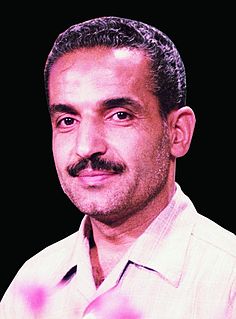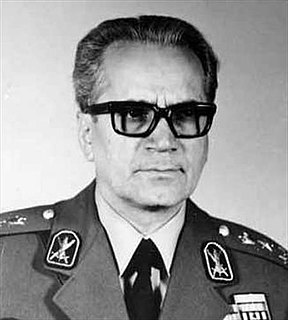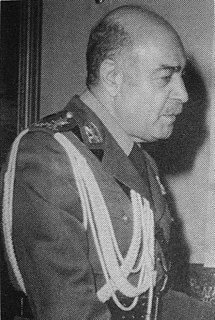
Mohammad-Ali Rajai was the second president of Iran from 2 to 30 August 1981 after serving as prime minister under Abolhassan Banisadr. He was also minister of foreign affairs from 11 March 1981 to 15 August 1981, while he was prime minister. He was assassinated in a bombing on 30 August 1981 along with prime minister Mohammad-Javad Bahonar.

Lieutenant General Nasser Moghaddam was the fourth and last chief of SAVAK. He succeeded General Nematollah Nassiri, who was arrested by the Shah's order in 1978. Moghaddam was convicted for corruption and sentenced to death under Ayatollah Khomeini's order on 11 March 1979, along with Nassiri and Nassiri's predecessor, Hassan Pakravan.

The Immortal Guard of Imperial Iran, also known as Imperial Guard, was both the personal guard force of Mohammad Reza Pahlavi, the last Shah of Iran, and an elite combat branch of the Imperial Iranian Army. It was created in 1942 and disbanded in 1979 following the Iranian Revolution. It was named after the Immortals, an elite unit of 10,000 Persian soldiers in the army of the Achaemenid Empire.

Jafar Sharif-Imami was an Iranian politician who was prime minister from 1960 to 1961 and again in 1978. He was a cabinet minister, president of the Iranian Senate, president of the Pahlavi Foundation and the president of the Iran chamber of industries and mines during the reign of Shah Mohammad Reza Pahlavi.

Arteshbod Gholam Reza Azhari was a military leader and Prime Minister of Iran.

This article is a timeline of events relevant to the Islamic Revolution in Iran. For earlier events refer to Pahlavi dynasty and for later ones refer to History of the Islamic Republic of Iran. This article doesn't include the reasons of the events and further information is available in Islamic revolution of Iran.

The real and imaginary human rights violations and casualties of anti-Shah forces during the Iranian Revolution, such as Black Friday massacre at Jaleh Square and Cinema Rex fire in Abadan. were blamed on the Shah's forces and contributed directly to his overthrow. Observers differ on how many died. The Islamic government uses the figure of 60,000 killed; in reference to this figure, the military historian Spencer C. Tucker notes that "Khomeini's regime grossly overstated the revolution's death toll for propaganda purposes". The sociologist Charles Kurzman, drawing on later more detailed records from the Islamic Republic, believes the number was closer to 2,000-3,000.

The Cabinet of Iran is a formal body composed of government officials, ministers, chosen and led by a President. Its composition must be approved by a vote in the Parliament. According to the Constitution of the Islamic Republic of Iran, the President may dismiss members of the cabinet, but must do so in writing, and new appointees must again be approved by the Parliament. The cabinet meets weekly on Saturdays in Tehran. There may be additional meetings if circumstances require it. The president chairs the meetings. The Supreme Leader has the power to dismiss cabinet members like ministers and vice presidents, as well as the President, at any time, regardless of the Parliament's decisions.

Mohammad Reza "Ajir" Ameli Tehrani was an Iranian physician and pan-Iranist politician. He served as a minister in the cabinets of Jafar Sharif-Emami and Gholam-Reza Azhari. He was sentenced to death by the Revolutionary Court, and subsequently executed on 8 May 1979.

Arteshbod Gholam-Ali Oveissi was an Iranian general and the Chief Commander of the Imperial Iranian Armed Forces under Mohammad Reza Pahlavi. He was the last general to head the Imperial Army of Iran. He is regarded as one of the most powerful and adept military generals in Iran's modern history.

Gholam Reza Pahlavi was an Iranian prince and a member of the Pahlavi dynasty, as the son of Reza Shah and half-brother of Mohammad Reza Pahlavi, the last Shah of Iran.

Abdul Reza Pahlavi was a member of Iran's Pahlavi dynasty. He was a son of Reza Shah and a half-brother of Mohammad Reza Pahlavi.

Amir Khosrow Afshar was an Iranian diplomat, who served as the minister of foreign affairs of Iran during the Shah era from 1978 to 1979.

Amir Hossein Rabii was an Iranian senior military officer who served as the commander in chief of Imperial Iranian Air Force from 1976 to 1979. He was the last commander of the force.

Arteshbod Jafar Shafaghat was a General officer in the Iranian Pahlavi Army and was the last Minister of Defense in Shapour Bakhtiar government. Jafar Shafaghat was the last governor of East Azerbaijan Province during the Pahlavi dynasty. He died in exile in Nice, France.

Hassan Toufanian was an Iranian Air Force General under the Shah of Iran. He was a graduate of the Iranian Military Academy and later served as commanding officer of Iran's flight academy. In 1977 he was the Shah's Vice Minister of War and led Project Flower, which entailed an economic deal between Iran and Israel which would have built cooperation and exchanged Iranian oil for an Israeli missile system, but which collapsed in 1979 during the Iranian Revolution.
Reza Azimi was a senior military officer during the reign of Shah Mohammad Reza Pahlavi. He was a general and held various military and government posts, including commander of the Imperial Iranian Ground Forces and minister of war.

Abdollah Hedayat (1899–1968) was an army officer who served as the chief of general staff at the Imperial Iran Army.

Sadegh Amirazizi (1905–1992) was an Imperial Iranian Army general and a politician who served as the minister of interior three times during the reign of Shah Mohammad Reza Pahlavi. Following the 1979 revolution he left Iran and settled in Paris, France. He died there in 1993 and buried in Behest e Zahra Cemetery in Iran.

The government of Shapour Bakhtiar is the last government during the Pahlavi dynasty that ended with the Islamic Revolution. The head of this 37-day government, Shapour Bakhtiar, was one of the leaders of the National Front. The National Front of Iran had announced in a statement on December 29, 1978 that if Bakhtiar accepted the post of Prime Minister, he would be expelled from the National Front. The day after the Prime Minister was received, his dismissal was voted on at a meeting of the Central Council, and his dismissal was decided by an overwhelming majority.

















